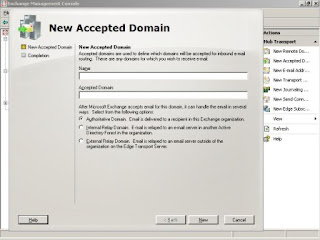•Workstation with 2 GB RAM and 1 GB free disk space
•Access to the internet to download the required installation files
•Java Development Kit (JDK) version 1.5 or version 6 installed










part 1: Exchange Server 2007 installation requirements
Exchange Server 2007 hardware requirements
Exchange Server 2007 requires a server with a 64-bit processor and a 64-bit operating system. It supports a variety of 64-bit processors, including Intel Xeon or Pentium processors that support Intel Extended Memory 64 technology (EM64T). 64-bit AMD Opteron and Athlon processors are also supported. Exchange 2007 will not run on the Intel Itanium (IA64) processor though.
I'm not sure if these other hardware requirements are official yet or not, but the information that I got from Microsoft was that Exchange Server 2007 will require a minimum of 1 GB of RAM (2 GB recommended) and a minimum of 1.2 GB of hard disk space.
While I am on the subject of hard drives, I should mention that all partitions must be formatted as NTFS. This includes the system partition and partitions containing Exchange Server binaries, transaction logs, database files, and any other Exchange-related files.
Exchange Server 2007 operating system requirements
Internet Information Server
The server on which you install Exchange Server 2007 must be running Internet Information Server (IIS). What is different from deploying Exchange Server 2003 though is that only the minimal IIS components should be installed. For example, you cannot install Exchange 2007 if the SMTP or NNTP components of IIS are installed.
Exchange Server 2007 infrastructure requirements
There are some fairly stringent requirements for the network that your Exchange 2007 server is connected to. For starters, the Active Directory domain functional level must be set to Windows 2000 or higher.
Furthermore, the domain controller that is acting as the schema master must be running Windows Server 2003. By default, the Schema Master role is assigned to the first domain controller in the domain, but you can move the role to another server if necessary.
In addition, all domain controllers and global catalog servers running in the Exchange 2007 site must be running Windows Server 2003.
The test environment used for this Exchange Server
Before I get started with the deployment process, I want to tell you a little bit about the test environment I used for this "Exchange 2007 test drive." Knowing exactly how my environment is configured may help you out if you try to duplicate any of the techniques I discuss.
For the purpose of the demonstrations herein, I am testing Exchange Server 2007 on an AMD Athlon 64x2 3400+ with 2 GB of RAM. It is running Windows Server 2003 R2 Enterprise x64 Edition with Service Pack 1.
Also, because Exchange Server modifies the Active Directory schema, I created a dedicated forest solely for the purpose of beta testing Exchange Server 2007. I did not want Exchange 2007 Beta 2 making any modifications to the schema of my production Active Directory database.
In addition to the machine that is running Exchange Server 2007, there are three other computers in my dedicated forest. One machine is running a beta of Longhorn Server, and is acting as a domain controller and the DNS server for the forest's only domain.
The other two computers in the forest are workstations. They are both running a beta of Windows Vista, and the copy of Microsoft Office 2007. Later in this tutorial, I use these two PCs to demonstrate using Microsoft Outlook 2007 in an Exchange Server 2007 environment.
Or you can Use VMWare - So that You can Create 2 Diffrent Environment ( Opearting Systems)
In this Video you can find that how Identity Manager will work, with Account, Resources, Access Control and Virtual Directory.